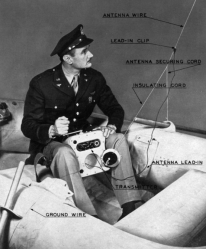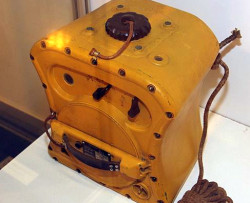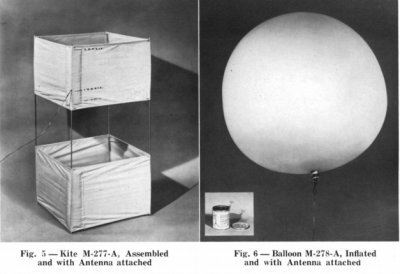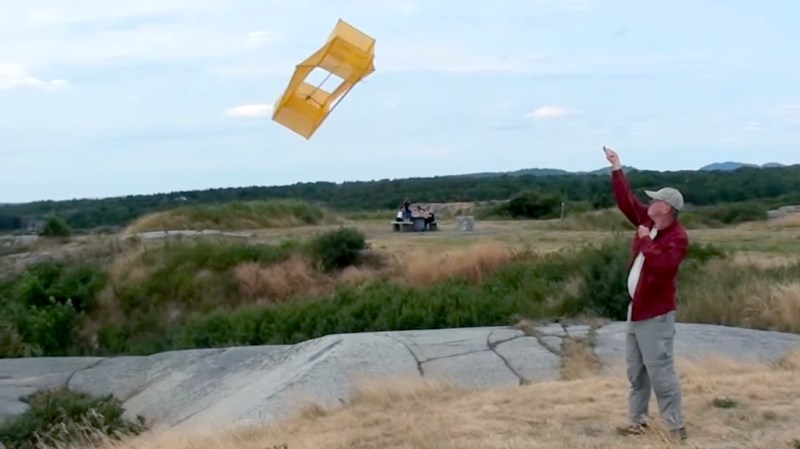Your airplane has crashed at sea. You are perched in a lifeboat and you need to call for help. Today you might reach for a satellite phone, but in World War II you would more likely turn a crank on a special survival radio.
These radios originated in Germany but were soon copied by the British and the United States. In addition to just being a bit of history, we can learn a few lessons from these radios. The designers clearly thought about the challenges stranded personnel would face and came up with novel solutions. For example, how do you loft a 300-foot wire up to use as an antenna? Would you believe a kite or even a balloon?
Why Such a Big Antenna?

The international rescue frequency in those days was 500 kHz. This allowed simple spark gap transmitters to be placed on lifeboats even in the 1920s. Unfortunately that is 600 meters wavelength! A quarter-wave antenna at that frequency is 150 meters long or nearly 500 feet.
After the Titanic sunk, ships maintained a watch on 500 kHz, and ground-wave propagation ensured a good range. Even after spark gaps fell out of favor, they continued to be allowed on lifeboats due to their simplicity. So by the time the war started, 500 kHz was the frequency everyone monitored for distress traffic
History

The German NS2 (or NSG2) was a two-tube 500 kHz transmitter with a crystal oscillator. In 1941, the British captured one and created their own version, the T-1333. A second captured unit went to the United States, spawning the SCR-578 and its transmitter, the BC-778. An SCR-578 had a folded metal frame for making a box kite and a balloon with a hydrogen generator. Water would cause the generator to produce gas and the balloon would carry one end of the antenna aloft. The 4.8W transmitter could reach about 200 miles with its 300 feet of antenna wire lofted into the air. You needed at least 175 feet of antenna out for the radio to work.

The designers knew you wouldn’t be able to erect that much wire in a life raft. The kite or balloon were workable solutions and would deploy the antenna from a reel mounted in the radio (you can watch a modern-day kite launch in the video, below). Not only that, they could obviously envision what the situation would be like on a tiny raft bobbing around. These radios all had a shape designed to clamp between your knees during operation. The hourglass-like shape spawned the nickname “Gibson Girl” after the illustrations of Charles Dana Gibson. They were also waterproof and made to float.
There were variations. The NSG2 produced 8 watts out using a crystal oscillator while the United States version didn’t use a crystal — they were in short supply — and produced less power. The T1333 used a flare gun to launch the kite folded up, which would deploy at 200 feet. It was also rectangular and had pads to allow the operator to grip the box in operation and didn’t have a balloon.
The entire kit weighed about 33 pounds and included a signal lamp, two balloons, two water-activated hydrogen generators, two rolls of antenna wire, and a parachute so you could drop the whole bag from an airplane.
A True Lifeline
It would be a pretty bad situation if you fished out your survival radio when you needed it and found the batteries were dead. That’s why these radios typically had cranks to generate electricity. No batteries to replace or wear out. If you had enough strength to turn the crank, you were on the air. The crank could also automatically send SOS.
If you want to read more about these old radios, check out [RadioNerd’s] scans of the military manuals. There’s a lot of detail there. For example, it explains that the hydrogen generator uses lithium hydride to produce hydrogen gas when exposed to water. The automated system for sending SOS, AA, or dashes was clever and something we’d do with a microcontroller today but in the 1940s, required mechanical engineering. The circuit description is interesting, too.
The design was durable. Both military and civilian aircraft used the SCR-578 or its direct descendant the AN/CRT-3 until the 1970s. The newer radio acted like the older one, but could also transmit on 8,364 kHz. The Russians started making copies of the original transmitter in 1945. The AVRA-45 is hard to tell from its American counterpart, apart from the lettering on the case.
Hindsight
I don’t know which German engineers at Frieseke & Höpfner GmBH designed the NS2, but they were clearly thinking about their users and willing to solve problems in the true hacker fashion. The shape is easy to grip, the crank does away with battery problems, and the radio is suited for its intended use. You have to wonder what other ideas they had for lifting the antenna before they settled for the balloon and kite combo. I also wonder why the British kite is so different and requires a Very pistol to launch.
Of course, this wasn’t the first example of a kite-lofted antenna. In 1898, a weather balloon lifted an antenna over Massachusetts and in 1901, Marconi’s antenna at Newfoundland would communicate with England while connected to a man-carrying observation kite. Military use dates back to at least 1905 with the United States Army using them as late as 1920. The British and Germans were using them around the turn of the century, too and the U.S. Navy had kite-based antennas on seaplanes in 1922. Still, the NS2 was a marvel of packaging and practicality.
The NS2 was the successor to the heavier NS1. While it did have a kite, it also had an ungainly aluminum antenna for use with no wind and it also relied on batteries. You can presume that by taking honest feedback on the NS1, the engineers were able to build the NS2 and they really hit the mark. After all, isn’t imitation the sincerest form of flattery? I doubt those engineers considered themselves hackers — that term wasn’t even in use then — but I do.
It is amazing how simple a radio can be if you are motivated enough. Don’t think hams haven’t used balloons before, either.
[Main image source: German WWII emergency kite by Helge Fykse]















Wondering about Amelia Earhart and emergency communicaton equipment, a quick search revealed that she apparently discarded a morse code key as “dead weight” since no one aboard could use it. While the emergency transmitter in the post could have made a difference, the 33 pounds noted is many times the weight of a code key. So my speculation stopped there…
The big “dead weight” savings that killed them was the decision to remove the trailing wire RDF system. At the time, the loop RDF systems were not as dependable. And then there were the communications problems caused by poor design/implementation decisions.
Just in time for Field Day :-)
I used to have a big spruce and muslin kite designed in the physics department at Washington State University for stability and flying as close to straight overhead as possible. One of the physics faculty gave it to me way back when. They were made for the Navy to fly antennas from the fantails of Destroyers during WWII. It won me many a kite flying contest. Sadly at another univ. I loaned it to an art grad student to duplicate and never got it back. It combined the features of a King kite with a very strong wood cross and some battens.
Now you have me wondering what the design is?
FWIW, I made a 1900 mile contact with a QRP radio (<5 watts), some stranded wire, and a plastic kite purchased at a drug store. Kite antennas can be very effective.
http://hpfriedrichs.com/radioroom/casual-qrp/rr-prqrp.htm
awesome article. Thanks for sharing
During WW II American aviators in the Pacific also had small depth charges that exploded when they reached the SOFAR (~4000 ft in mid-latitudes) layer. This created a rising exponential waveform that dropped to zero at the arrival time. This allowed approximately locating downed airmen by correlating records from multiple receiving stations.
The signal would reach out to 1900 miles and 2 signals gave a sufficient geodetic fix to locate the aviator.
c.f. “Principles of Underwater Sound”, Robert J. Urick
The very pistol launch was probably to get the kite above the still layer of air. At 150’ there’s often a breeze even when it’s still at ground level.
Very pistols being common and reliable – and probably already in the emergency kit – they probably decided this was simpler than a balloon and hydrogen generator?
All Allied bombers carried Very pistols. Among other uses, they were used during final approach to home base to signify significant damage (yellow) or injuries (red) so that their landing could be prioritised, and fire trucks and ambulances primed to chase them down the runway. The B17 had a port at the top of the cockpit that the muzzle of the Very pistol could be inserted through to fire flares. I’m not sure about other planes, or whether they just fired through an open window. Most fighters carried them too – in the event of a forced landing in occupied territory they would be used to destroy the plane.
I still have a M277A Kite. Got it from my Air Force brother 60+ years ago.
Wow! I had a Gibson Girl transmitter just like in the top photo. It was not an easy thing to crank but I didn’t have the leg straps which would have made it less tiring. Also lucked onto two of the rocket-launched metal-framed boxkites. I sold the transmitter and one of the kites about 5 years back but I still have one kite. It needed a fair breeze to fly.
Now as luck would have it there happens to be a giant Kite festival here in Brisbane this weekend, I may take it and my trusty Jalbert parafoil along. But since it’s a metal frame it would not be too good if it came down on someone’s head… oh dilemmas dilemmas.
Fun factoid 1: the boxkite was used because they fly stable without the need of a tail.
Fun factoid 2: the seawater-activated hydrogen balloon-in-a-can option was (is?) still available to buy from a european militaria dealer. I considered getting one posted to Australia to complete the radio but decided it was not really worth the risk to be sending a thing like that by airmail given the consequences if it inadvertently went off!
Just another recollection about the GG transmitter. The crank handle was stored in a recess on the case. There was a clip to keep it secured, but once it was taken out and inserted into the top socket ready for cranking, there was no securing method for that. It would have been quite possible to inadvertently lose the handle overboard!
Years ago, a friend and I were playing with kite antennas in preparation for Field Day. It was a bright and sunny day. We were anchored on the outskirts of the main anchorage near Hart-Miller Island on the northern part of the Chesapeake Bay. I flew a parachute kite on about 400′ of line, and lofted about 250 feet of kynar coated wire used for wire-wrapping. We went to attach that wire to an antenna tuner. Then one of the guys accidentally touched the antenna lead and got a massive static shock that threw him across the deck of the boat.
He was okay except for some bruises. But the lesson learned is this: You don’t need stormy weather to get hurt by static electricity. Being careful to touch only the insulation, we attached the wire to the antenna tuner with a high value resistor to ground. This bled off the static charge. The first station we talked to was in Germany. The antenna worked quite well.
We discovered this with a balloon antenna one field day. You want a shunt match across a coil to DC ground the antenna :-)
I was going to comment regarding. I recall a video on Youtube that was showing the electro-cautery/burning effect from the wire.
The video was still in my YT History:
https://www.youtube.com/watch?v=L50x35df2nI
I like how the model in the picture is impeccably dressed: cap on, tie neatly tied, and jacket buttoned, as he sits in his life raft and cranks for help.
My father ON4DU/SK used to take the Gibson Girl box kite at the belgian beach back in the 70’s to raise a long wire antenna and he made lots of contacts with hams in the uk etc.. He was using a RT-77/GRC-9 radio (pronounced the greek radio). Some people recognized it in the sky from afar and came to have a chat. Being less than 10 years old I learned the hard way what static electricity is and why a small neon bulb is needed between the antenna post, the ground post and a stake in the ground. That static electricity can be hundreds of volts in moderate wind.
The particular shape of this kite makes it so that it tends to stay high up in high wind. You could find those kites in army surpluses back then. I still have a few Gibson Girls, a couple kites and a dozen unopened cans.
Another remarkable airborne support for long wire antennas used in modern versions of rescue radios is the SEB-42-ALV (NSN 1H5820-01-149-5467) which is in the form of a giant manta ray (it’s a flat shaped balloon and needs to be filled with hydrogen) that pulls up in high wind instead of being carried away. Unlike the Gibson Girl box kite made of cotton fabric those are one time use as made of extremely thin material.
A dopero kite would be better, if you could compact the spars.
Great to see this covered here. A couple minor corrections regarding the history though, if I may: the antenna flight in Massachusetts was in the summer of 1899 (not 1898) at the Blue Hill Meteorological Observatory and they used a kite, not a balloon. These experiments were carried out at the request of Samuel Langley, Secretary of the Smithsonian Institution, who was hoping that getting an antenna a mile or more into the air would result in correspondingly greater reception distances. As it turned out, the practical limit was only a couple hundred feet due to the collection of electrical charge on the wire, which easily overwhelmed the receiver.
Does anyone know where I can find/purchase the specific antenna wire used in these radios?
Search for AT-984A/G on ebay, not exactly the same but close. Otherwise something similar to Philmore 15-635 but thinner and less stiff would do.
Bernard, danke schoen!
Great article topic. Further reminds me of the goal to build and deploy a kytoon or kite balloon, most likely with drone controls for better maneuverability and recovery capabilities.
I recall reading somewhere not long back, regarding automated reals… I think for boating using kites. I forget exactly, though was thinking the automated kite control would be useful in the more area monitoring detail for longer term loft.